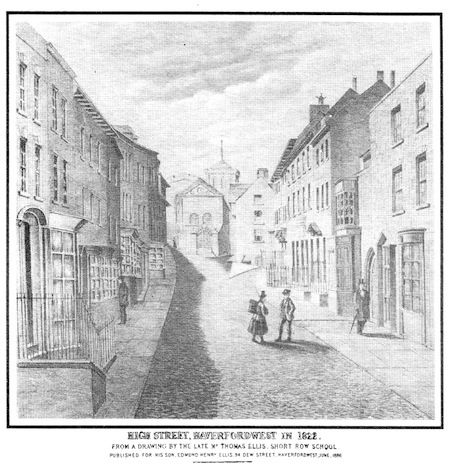Guild Hall & Boer War Memorial

Guild Hall seen from High Street, 1822
The area that forms the triangle inside the railings was formerly the most important building in the town. It has been referred to by several names; ‘The Guildhall’, ‘Town Hall’, ‘Market House/Hall’. The confusion or multi names arise from the fact that the large building served several purposes. Law courts were on the upper floor and the town market was conducted from the vaulted ground floor.
This was the second such building here, erected in 1701 to replace a smaller and decrepit older one. This more modern structure, designed by London architects, using a model of the time, was Jacobean in style, was tall with two huge windows facing down High Street and had entrance gates at the narrow end of the triangle.
The problem commented on by contemporary historians suggested that much of the impressive east end of St Mary’s Church was hidden by this Guildhall. By 1834 the usage and deterioration of the building raised concerns amongst those in power sufficient to suggest that it was now an embarrassment to expect visiting judges to have to journey through a town still very medieval in layout and appearance and arrive at this old building.
Amongst the radical improvements made to the town over the following ten years were included a new law court, the Shire Hall, positioned at the bottom of High Street with the market element being relocated to the top of Market Street.
This old Guildhall was sold at the time for ten shillings, the proviso being that the buyer demolished it and cleared the site.
As you stand here, you may wish to consider the sentences handed out to thousands of ‘criminals’ not far from this spot over hundreds of years; the last being William Roblin, (who actually was a murderer), who was sentenced to death becoming the last man to be hanged at Haverfordwest Castle in April 1821.
This building wasn’t the only large structure that impeded views of St Mary’s Church; on the Dew Street side of the church for many years was the Fish/Butter Market which was demolished in the 1950s for road improvement.
In 1921, the site was chosen for the erection of a memorial to those fallen in the South African War, or Boer War, 1899–1902.
Come back down the steps and continue down High Street for a few yards...
Base map from openstreetmap.org